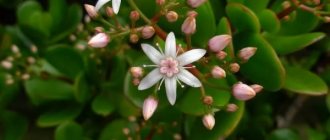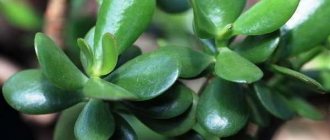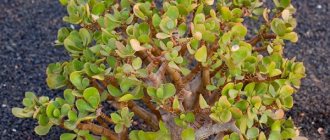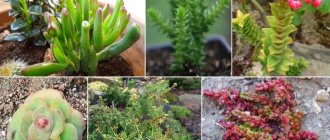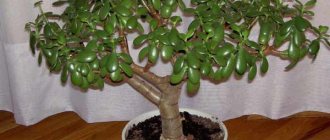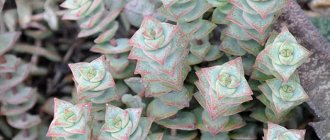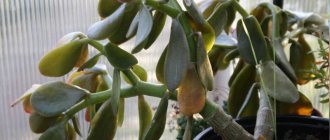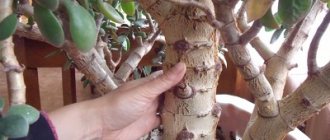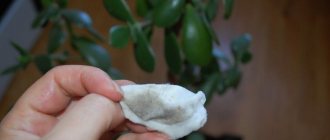Flower growers who prefer not to suffer from the complex care of ornamental and exquisite plants opt for the Crassula. Among people, this indoor plant is called the money tree. It is loved for its ease of care and evergreen leaf color. But, despite its unpretentiousness, it can also get sick.
The main problems that the owner of such a plant may encounter are red or limp leaves. Each of them is worth considering in more detail.
Why do the leaves become limp and fall off?
In addition to the main reasons for the loss of leaves on the money tree described above, there are several more that are directly related to the characteristics of caring for the plant at different times of the year.
In summer, the money tree must be protected from the scorching sun, drying out of the soil and too dry air, drafts and overheating of the substrate in the pot. It should be watered daily, moderately, in the evening, removing excess moisture from the pan.
In the fall, it is important to bring the money tree indoors in time. Night cold temperatures below 10ºC can cause hypothermia of the root system, which can cause disease or stress
In winter, you should not place a money tree near heating appliances. In the short days of late autumn and until mid-winter, the plant needs additional lighting. The optimal length of daylight for a money tree is 10-12 hours; based on this condition, it is provided with additional lighting.
Another winter problem is dry indoor air. Although the fat woman is indifferent to humidity, once a month she will benefit from a small warm shower.
There are a number of other problems that lead to the leaves of the fat plant falling off, but they relate to the plant’s habitat.
Money tree is an energetically powerful plant. It is strongly connected with its owners, often falling ill with them. Therefore, it often happens that the tree begins to wither if one of the household becomes seriously ill.
If the money tree is kept under normal conditions and its care is carried out “according to the textbook,” experienced flower growers advise paying the owners’ attention to their own health. Often, exacerbations of chronic diseases of family members have a negative impact on the plant: it grows poorly, the leaves wither and fall off
Here it is not the plant that needs to be treated, but people. With the recovery of the owners, the money tree quickly comes to its senses
Often, exacerbations of chronic diseases of family members have a negative impact on the plant: it grows poorly, the leaves wither and fall off. Here it is not the plant that needs to be treated, but people. With the recovery of the owners, the money tree quickly comes to its senses.
Also, the energetic connection between the fat woman and family members is clearly expressed when conflict situations arise. If quarrels, scandals, and conflict situations often occur in the house, the money tree, like a tender young lady, begins to mope, expressing its protest by dropping leaves. And in this case, it is not the plant that needs help, but people. When home calm and peace are restored, the tree will also be restored.
Causes of redness of Crassula leaves
Red pigment is found in the vegetative organs of almost all plants. In deciduous plants, it usually appears in the fall, when the chlorophyll responsible for the green color is destroyed.
In most Crassula species, the edge of the plate turns red in its natural environment. In culture, the Crassula has adapted to indoor conditions, feels good in partial shade, but has lost its colored rim.
If the leaves of the money tree turn red, this is not always a harmless phenomenon; the owners must understand the reasons.
Lighting
Most often, the change in color of the vegetative organs of the Crassula is associated with a move to a sunny place. If plants are moved outside in summer, the lighting will be more intense even in partial shade. On the south window or balcony, the flower is exposed to direct rays, which also causes the plates to turn red.
This makes the fat woman look prettier, but sometimes a change in color signals a sunburn.
Flower growers are well aware of its signs on ordinary plants. When thin leaves are exposed to aggressive rays, or the remaining droplets from spraying turn into lenses, whitish drying marks appear. But the fat plant is a succulent, it is not sprayed, and its burn often manifests itself a little differently.
In addition to reddening of the plates, the owners should be concerned about the following signs:
The last two symptoms may be associated with the characteristics of the species or variety, for example, in the Dark Purple Crassula.
Watering
If the flower is not exposed to aggressive sunlight, and the leaves turn red entirely, wither and wrinkle, the owners may have dried out the soil. The culture requires little watering, but there is a limit to everything, especially in summer.
Other reasons
To a sudden change of place, when the fat plant is brought into the light from the depths of the apartment, the flower, even if it does not receive direct rays, will react - the leaves will begin to turn red. The plant needs to be accustomed to light gradually.
Too nutritious soil is not suitable for Crassula, as is excess fertilizer:
When the fat plant is taken outside or returned indoors from summer holidays, the plant experiences stress. It may turn red, but will quickly return to normal.
Major diseases
Why the money tree does not grow, leans to the side, and also has a drooping appearance - we will try to answer these questions.
A tree can become sick for many reasons:
- oversaturation with fertilizers can cause leaf fall;
- pests may appear;
- Leaves may fall off and turn black due to bright lighting (direct sunlight);
- if overwatered, the root system may rot;
- when the soil is overdried, the leaves dry out and begin to fall off;
- too cold water will cause the leaves to drop;
- a bacterial or fungal infection leads to the appearance of red-brown spots;
- The money tree also dies from old age.
Silvery patina
When a silvery coating in the form of white dots appears on the leaves, it is urgent to reduce watering and observe the flower. After drying the soil, Crassula will “come to its senses” and no further measures should be taken. Just don’t oversaturate the plant with water in the future.
Root rot
A common problem with overwatering is root rot, which leads to the death of the tree. At the same time, the stem is separated from the roots and the fat plant slowly begins to die. The tree withers, its top collapses, the leaves dry out, and it is no longer possible to revive it. Excessive flooding leads to the death of the fat woman. What to do? You can restore a flower only by cutting off living cuttings. Dip them in water and wait for new roots.
There is another reason for death: if the money tree freezes. Although this plant can tolerate temperatures around 0 °C, it is still not frost-resistant. To help, cut off dead branches and stems, sprinkling the cut areas with charcoal.
Changes in leaf color and structure
By the appearance of the leaves you can determine how the plant is feeling. If the leaves become soft and limp, this indicates that the flower is over-watered. Treatment in this case consists of examining the root system. To do this, you need to remove the fat plant from the pot and remove the rotten sections of the root with a knife. The bottom sheets can also rot, so they need to be cut off. Treat areas of cuts and breaks with charcoal. You will need a new (or well-washed old) pot and new soil. After transplanting Crassula, do not water it immediately, give it time to rest and take root, and stop watering until it is completely cured.
Another sign of the disease is wrinkled leaves. In this case, the flower signals that it is too hot, and the leaves wrinkle from excess heat, and if measures are not taken in time, they will begin to turn yellow and die. It is very simple to cure a tree - in the summer, do not leave the flower on the windowsill, where direct sunlight falls.
Crassula will feel best on a loggia or balcony, where there is a lot of fresh air and light. In summer, watering once a week is sufficient. In winter, find a place for the flower away from heating devices and radiators, water once a month.
Leaves may become covered with white spots, indicating high humidity. Thus, Crassula releases excess water through the pores in the leaves.
Basic succulent diseases and home therapy
DIY money tree bonsai
Unfortunately, Crassula, like many other plants, can be subject to various pathologies. Many diseases of the money tree occur due to non-compliance with flower care rules. Therefore, questions often arise about why the fat plant has soft leaves and what to do to prevent them from falling off.
Silvery patina
A silvery coating on green leaves occurs as a response to stress. Often the cause is non-compliance with the watering regime and a sharp change in temperature downward. The symptom may also appear when lighting conditions change.
There is only one treatment in such a situation - wait until the plant recovers on its own. Plaque is dead cells that appear on the surface of the leaves after a stressful situation. Gradually it will disappear on its own.
Gray plaque
Green bumps
The appearance of green pimples on the leaves is possible for 2 reasons - excess moisture and damage by scale insects. To determine accurately, it is recommended to carefully examine the plant. If damaged by a pest, appropriate treatment is started (this will be discussed below).
If the reason is frequent watering and stagnation of moisture, then it is necessary to adjust the watering - it should not be more than 2 times a week.
Attention! At ambient temperatures below 23 degrees, one weekly irrigation is sufficient.
Red or purple color
Sometimes the leaves of the fat plant turn red or acquire a purple tint. This happens for several reasons:
- constant contact with direct sunlight;
- lack of fresh air;
- lack or excess of nutrients in the soil.
It is possible to get rid of redness if you choose a different location for the succulent and ventilate the room more often. Fertilizing is carried out with special fertilizers for succulents, preparations are prepared according to the instructions for use. With proper care, the plant cannot turn red.
Leaves wither and turn yellow
Sometimes you may notice that the leaves of the crassula become flaccid and acquire a yellow tint, become wrinkled and fall off. This happens more often because the plant is hot.
During the summer months, the plant will be more comfortable outdoors than indoors. It is important to ensure that there are no drafts or exposure to direct sunlight.
Presence of burns on leaves
The tree is losing its leaves
Falling of leaves on Crassula is observed quite often. In advanced cases, only a few pieces may remain on the stem. The reasons for this phenomenon are:
- natural state - old and lower leaves begin to fall over time;
- excess moisture in the soil - then the leaves may wrinkle and dry out;
- use for cold water irrigation;
- lack of moisture - all life processes slow down.
Normally, the Crassula intensively sheds its leaves in winter. This is necessary to renew the plant. In such a case, there is no need to carry out any actions; the young leaves will grow on their own after some time.
If the cause of the fall is a disrupted irrigation regime, then it is recommended to monitor this process and normalize it.
Brown or brown spots
The appearance of brown or brown spots on the plant, which then turn black, indicates that the plant has been exposed to fungal diseases. This happens as a result of severe waterlogging or too cold temperatures.
Important! To get rid of the disease, treatment with special antifungal fungicides will be required.
The medicinal solution is prepared according to the instructions and the plant is treated. If necessary, the procedure is repeated. Diseased and wrinkled leaves need to be removed.
Often this sign indicates a scale insect infection, which can also be eliminated using specific means.
Root or stem rotting
Rotting of the stem and roots occurs with constant moisture and low air temperatures. In general, the fat plant does not need frequent irrigation. The plant accumulates moisture in its leaves. Therefore, frequent watering often leads to rotting and the plant dies.
In this case, there is wilting of the foliage and an unpleasant smell of rot from the soil, which can be easily felt by the owner of the plant.
The only way to cope with the problem is by replanting the flower in another soil and pot.
Attention! Rotten roots are removed, and the cut areas are treated with activated carbon.
Stunted growth
Often, a fat plant planted a long time ago simply stops growing and freezes in one place. There are several reasons for this condition:
- unsuitable small pot;
- no transplant for a long time;
- damage by harmful insects;
- lack of nutrients.
Actions are carried out after the exact reason for the lack of growth in the plant is determined. First of all, it is recommended to transplant the fat plant into a larger pot. During the process, the plant is carefully inspected for rotting and pest damage. If necessary, treat with fungicidal preparations or insecticides.
Soft and thin leaves
Often the leaves of the fat plant become thinner and become soft. The reasons are excess moisture, insufficient lighting or unsuitable air temperature.
What to do if the leaves of the money tree become soft and limp? First of all, try to determine the cause of this phenomenon. If there is excess moisture, it is recommended to replant the plant and treat it with special preparations. The pot is moved to a bright place, protecting it from direct rays of the sun.
White dots
The appearance of white spots on the foliage indicates excessive moisture and watering. Being in a room with high humidity also leads to a similar problem. Thus, the flower gets rid of excess water through the pores in the foliage.
To eliminate the problem, it is recommended to reduce the amount of watering and spraying, and move the plant to a drier room. It is imperative to subsequently control the irrigation process.
Leaf burn
The appearance of yellow or brown spots on the foliage indicates possible burns. They arise as a result of the flower being in direct sunlight. The problem may appear due to the fault of the owner, who provokes moisture to enter the leaves exposed to the sun.
The affected leaves are removed, and the plant itself is moved to another place with diffused light or shaded.
Small leaves
Crassula loves diffused light. With its deficiency and lack of nutrients, the leaves on the plant become small. You can cope with the problem by moving the plant to a more suitable place or feeding it with special fertilizers for succulents.
Important! In most cases, crassula diseases arise as a result of violation of the rules of care.
The plant does not like direct sun and frequent heavy watering.
Leaf diseases
What to do: the money tree falls from gravity?
This problem is only possible if the pot with Crassula was not turned in relation to the light, its crown became one-sided, and the tree lost stability.
How to strengthen the trunk of a crassula?
To solve the problem, an adult plant is transplanted into a slightly larger pot, slightly reducing the load on one side by pinching it.
It is advisable to replant in the spring, but if the situation does not tolerate delay, you can use the transshipment method, that is, carefully remove the plant along with a lump of earth, place it in a larger pot, and carefully fill the gaps between the soil and the walls of the pot with substrate.
The shape of a young plant can still be adjusted by rotating it around its axis. The plant reaches for the window glass, the only source of light, and the main trunk bends.
Timely attention to the shape of the money tree will allow you to get a slender plant with uniform growth and a neat crown. Having created the Crassula optimal conditions for development, you can be sure that problems and diseases will not interfere with growing a beautiful, strong plant, signaling to its owners about the well-being of the house in which it lives
Having created optimal conditions for development of the Crassula, you can be sure that problems and diseases will not interfere with growing a beautiful, strong plant that signals to its owners the well-being of the house in which it lives.
Causes of the problem
The fat woman herself signals her owners about her problems and illnesses. It's important to be careful. This is primarily manifested by the condition of the foliage. If leaves begin to fall, then it is worth taking action. The first sign of trouble may be the money tree's leaves becoming soft and then dropping.
Most often, leaves fall off due to extreme heat or excessive watering. The tree does not really like wet soil. The soil should be slightly moistened, so in summer, despite the heat, you should not get carried away with watering. It will be enough to carry it out after 2-3 days. But it is best to focus on the condition of the soil.
During the heating season, leaf fall can be caused by a lack of air humidity. Always in winter, the plant slows down its growth, fewer fresh leaves appear on it. They don't grow much and remain small and thin. It is very important to preserve mature leaves, this can be done by regular misting to replenish moisture from the outside of the plant, preventing the tree from wilting. The water should first be left standing for some time until it reaches room temperature. Water that is too cold or too hot can have a negative effect on the foliage.
Main plant diseases
Crassula, like other succulents, is equipped with a protective mechanism developed over centuries of growing in dry and hot climates. The pulp, which accumulates moisture, as well as cilia and thorns, aerial roots that collect dew drops, serve the plant to store more water.
Silvery patina
A whitish coating may appear first on the stems, and then at the base of the leaves and spread to the entire leaf blade. This condition is preceded by a change in the structure of the leaves and stems - they become flat, sluggish, the trunk may bend toward the ground.
Reasons for this condition:
- Intensive watering. By over-moistening the soil, you cause rotting of the roots and all above-ground parts. Stagnant water and waterlogging of the soil are one of the reasons for the softening of leaves, shoots, and deformation of branches.
- Lack of drainage layer at the bottom of the pot. If excess water does not drain into the pan after watering, the roots rot and Fusarium rot develops.
- Spider mite infestation. These small insects leave a whitish web that looks like clumps of cotton wool. The webs are so thin that they look like silvery fluff at the base of the leaves and on their lower parts.
You can get rid of silvery plaque only after determining the reason that caused this condition of the money tree:
- fusarium rot has an unpleasant moldy odor;
- with improper care, leaves and trunks soften almost immediately, even before a whitish coating appears;
- insects that attacked the plant can be seen at the base of the petioles and on the underside of the leaves.
In case of fungal infection, fungicides are used, the solution of which is treated with the leaves of the plant, as well as, in case of severe infection, the surface of the soil and the edges of the pot. It is better to transplant the succulent into a new container using fresh substrate.
Insecticide treatment is suitable for insects. Treat each leaf in turn with a cotton swab soaked in the solution or use spraying.
In any case, all affected leaves and even shoots must be cut off so as not to lead to the death of the plant. In advanced cases, when more than 2/3 of the fat plant is affected, it is necessary to propagate using a healthy apical shoot or a lateral cutting.
Root rot
Another common disease of Crassula is root rot. The disease is caused by fungi. Main symptoms:
- the stem darkens;
- rot gradually spreads to the roots;
- the above-ground part fades;
- the leaves become discolored, “wet” brown spots and constrictions appear on them;
- growth overall is slowing;
- Over time, the leaves fall off and the stems bend to the ground.
Causes of rot:
- excessive watering;
- lack of soil disinfection before planting seeds or propagating the money tree in any other way;
- contaminated equipment or growing pots;
- low room temperature.
Fungal spores are spread with air currents, during watering, carried on hands, clothing or tools, as well as by flying pests. Therefore, the disease can simultaneously affect all the flowers in the room.
To effectively combat this problem, fungicidal drugs are used:
- Fundazol;
- Trichophyte;
- Topaz;
- Fitolavin;
- Mikosan;
- Bordeaux mixture;
- copper sulfate.
For prevention purposes, it is necessary to choose high-quality planting material, and before replanting or primary planting, disinfect the soil and containers, as well as gardening tools. Remove dead plants immediately. It is not recommended to feed the soil too often. Watering standards must be observed.
Changes in leaf color and structure
The leaf blade of the money tree is the first to respond both to attacks by pests and diseases, and to improper care. If it softens, becomes sluggish, watery, this indicates excessive watering. It is necessary to inspect the roots, carefully remove the plant from the pot, remove damaged parts with a knife or pruning shears, and transfer to a new pot with fresh substrate.
The lower rotten leaves should be cut off, and the cut points should be treated with crushed charcoal. Immediately after transplanting, do not water the plant; let it take root and rest.
Sometimes the leaves turn yellow and curl. This indicates that the room is hot and very dry. Do not place the flower in direct sunlight, spray it additionally and use a warm shower to moisturize. If there are heating devices in the room, you can use a humidifier, place containers of water next to the pot, or use a tray with wet sand.
Crassula can be cured with proper care - do not over-moisten the soil, monitor the level of illumination, avoiding direct sunlight on the leaves, and ventilate the room.
Why does the Crassula die?
The flower dries up
The succulent begins to dry out and shed its leaves when there is excess soil moisture or the root system fills the entire space of the pot. The plant will be saved by drying the soil and rhizomes and replacing the container with a larger version.
The crown turns pale and crumbles
Probable reasons:
If the top of the Crassula has faded and began to crumble, you should stop feeding for a month, reduce the amount of moisture or add small portions of water, and let the watering liquid settle in advance.
Crassula froze in winter
Homemade succulent easily copes with short-term frosts down to 0 degrees, but crassula cannot withstand more severe conditions. A frozen tree can be saved if you cut off the dead areas, treat the cut areas with charcoal and continue caring. No additional measures are required.
The shoots are rotting
Brown, rotten areas on the tree are possible due to excessive watering or waterlogged soil. Earthen coma needs to stand dry for 2-3 days. If drying does not give positive results, the gardener can help by rooting a healthy shoot to obtain a young plant.
Fertilizers and biostimulants will provide restoration processes for fatty grass in case of illnesses. Timely watering and maintaining optimal air temperature are important. You also need to remember that the plant may turn red in the open sun.
Caring for a succulent has a positive effect on the health of the flower and prosperity in the home.
Source
What to do if the fat woman is frozen
If the money tree is frozen, it immediately becomes noticeable by its appearance. The branches and leaves of a frozen plant become watery, begin to wither and gradually turn black. How to save a money tree if it is frozen:
- All frozen parts of the tree must be cut off immediately, sprinkling the wounds with charcoal or activated carbon powder;
- If the soil in the pot is frozen and there is a danger of the roots freezing, then the fat plant must be removed from the soil and the roots inspected. Damaged parts of the roots should be removed, after which the plant should be planted in fresh soil. Additionally, you can treat the tree with Epin's solution to give it new strength;
- If the upper parts of the fat plant remain intact, then cuttings can be cut from them for rooting and growing new healthy plants. The cut cuttings need to be dried a little in the air, and then planted in the ground. If cuttings cannot be taken, you can take a few intact leaves and grow new plants from them.
How to resuscitate a fat woman after an illness
Myrtle - care at home, how to reanimate if it has dried out
After all signs of diseases and infections have been eliminated, the plant must be given rest and the rules of care must be carefully followed.
Watering is carried out infrequently, and care is taken to ensure that the soil is not over-moistened.
If necessary, the plant is pruned and replanted. If the stem is completely separated from the root system, then the best solution is to root the cuttings and grow a new plant.
What does money tree cure?
The benefits of having a money tree in the house are not limited to the beneficial qualities of the composition of the leaf juice. Many people get it only because, according to Japanese belief, the presence of this plant in the home ensures the financial well-being of the owners. There are even legends about how rich people, wanting to further increase their existing wealth, started a money tree. But due to neglect, the plant died, taking with it the success and prosperity of the busy rich, turning them into beggars.
A plant that attracts wealth
From a medical point of view, Crassula foliage can help treat certain diseases. The arsenic contained in the juice is present in each leaf in sufficiently large quantities that can be used to prepare an antimicrobial solution used as a rinse. They wash shallow wounds and abrasions, preventing bacterial infection.
In small doses, adding fatty juice to drinking water can help heal ulcers in the digestive system.
Attention! Ingestion of the juice of a plant containing arsenic is possible only under the supervision and with the permission of the attending physician. The composition of the leaf juice of Crassula is close in its chemical parameters to drugs that help fight certain types of oncology
It is worth keeping in mind that its uncontrolled independent use can lead to irreversible negative consequences.
The composition of the leaf juice of Crassula is close in its chemical characteristics to drugs that help fight certain types of oncology. It is worth keeping in mind that its uncontrolled independent use can lead to irreversible negative consequences.
Crassula leaves have red-brown or yellowish spots
Brown, brown and white spots on Crassula leaves indicate that the plant is infected with a fungal disease. Treatment of a fungal infection at the initial stage must be carried out with fungicides, strictly following the instructions for use of the drug.
The scale insect is a small insect (up to 5 mm), covered on top with a shield similar to a turtle shell. They settle on the leaves, trunks and petioles of the plant. When affected by this pest, the fat plant quickly weakens. The leaves first become spotted, then turn yellow and fall off. If treatment is not started in time, the plant may be lost.
Description of Crassula (money tree)
Crassula ovoid (crassula) comes from South Africa and is accustomed to rather harsh living conditions: dry air, drought and poor soils. Like most plants in this area, Crassula is a succulent and has a powerful, thick stem and dark green fleshy leaves - everything that can accumulate moisture for a long period of absence of rain.
The height of the Crassula in nature can reach 1.5 m. A feature of the plant is a rather sparse root system with an impressive trunk. Therefore, for Crassula they choose a wide but shallow bowl. This is necessary in order to avoid stagnation of water and rotting of the roots. Crassula blooms, but this event is extremely rare and occurs only with good care and in comfortable conditions. However, flowers are not her strong point; they are small, white, and collected in inflorescences.
Optimal conditions for keeping Crassula
Crassula is very popular among gardeners. For its shiny oval-shaped leaves, Crassula received the name “money tree”. According to the teachings of Feng Shui, this plant senses the mood of the owner, and is also able to attract financial well-being into the house and predict material expenses or income. Believing it or not is a personal matter for everyone. Nevertheless, flower growers are trying to create the most comfortable conditions for Crassula for growth and a chic appearance.
Crassula loves well-lit places - a southern window sill is ideal for her
Table: conditions for growing Crassula
| Period | Lighting | Temperature | Watering | Fertilizer |
| Summer | A bright place, allow direct sunlight only before 11 a.m. and after 4 p.m. | 20–27°C | Once a week after the top layer of soil has dried out | Once every two weeks, fertilizer for succulents, water with the solution according to the instructions |
| Autumn | The brightest place | 18–25°C | Twice a month | Not required |
| Winter | The brightest place | 12–15°C | Once a month | Not required |
| Spring | The brightest place, limit direct sunlight | 20–25°C | 2–3 times a month, depending on the drying of the soil | Once every two weeks with fertilizer for succulents in the proportion specified in the instructions for the drug |
A little about the Crassula
The plant, the problems of which will be discussed further, has several names. Among the most popular are:
- Money Tree;
- Crassula;
- monkey tree;
- fat woman
The tree comes from South Africa.
Crassula is a perennial evergreen plant. This is a tree with a woody trunk and thick fleshy leaves. Under natural conditions in its homeland, the money tree can reach a height of 3 meters. In indoor conditions, the plant does not grow for more than one and a half.
Pest control and photos
Pests don’t really like to settle on Crassula, but from time to time it suffers from their invasion.
Why does a white coating appear on the Crassula plant (white spots or dots on the leaves): what is it?
Sometimes in the axils of the leaves of the money tree you can see a white coating, similar to cotton balls. This is a signal that a mealybug has settled on the plant. In order to get rid of it, you need:
- wash off the pest with warm water from the shower;
- wash the fat plant with a small brush with a thick foam of laundry soap, then rinse the plant with clean water;
- treat with infusion of garlic or tobacco, decoction of cyclamen tubers. Such treatments are carried out 3-4 times a month.
The scale insect affects not only Crassula, but also many other plants, for example: Hoya, Poinsettia succulent, Cereus cactus.
If the mealybug is not dealt with, it will feed on the sap of young shoots, which will lead to weakening of the plant, slowing down its growth, loss of leaves, and the appearance of a colony of sooty fungi on the Crassula. The white coating on the plant must be rubbed between your fingers in order to distinguish a mealybug infection from a fungal infection.
It is much more difficult to get rid of spider mites. Its presence can be noticed by small yellowish spots on the leaves and threads of cobwebs.
The reason for the appearance of this pest is warm and dry air, so by spraying the plants regularly, you can avoid the appearance of mites on the fat plant. In the early stages of damage, you can treat the money tree with garlic or tobacco infusion, or soap suds.
Such measures are not always effective; most often, neighboring plants are also affected by the mite.
In this case, only insecticide treatment will help. They need to treat not only the plants, but also the surface on which they stand, as well as flower pots to destroy clutches of spider mite eggs.
The scale insect can be noticed only at a late stage of infection, when red-brown plaques (spots) appear on the bases of the petioles of the money tree and the back of the leaves along the veins, that is, the pest can be seen with the naked eye.
The following measures are being taken urgently:
- Scale insects are removed by scraping them from the surface of leaves and shoots;
- the fatty mushroom is wiped with tobacco or soap solution, washed with warm water;
- treat the plant with a systemic insecticide.
With a severe scale infestation, when all the leaves are covered with sweet sticky secretions, it is very difficult to cope with it.
REFERENCE. The soap solution for spraying is prepared in the following proportion - 10 g of potassium, green or laundry soap per half liter of water. Before soap treatment, the soil in the pot must be covered with film.
What to do to revive Crassula
The most common problem in keeping Crassula is trunk rot. Having received a beautiful mini-tree with fleshy foliage, the beginner, apparently, succumbs to the false impression that such greenery must be fed intensively, and begins to mercilessly flood the Crassula.
Meanwhile, if the soil in which the crassula grows is not allowed to dry out, excess moisture at the root collar will cause tissue rotting and the stem will separate from the roots. In this case, it is impossible to revive the plant.
The plant can only be saved by rooting cuttings. To do this, you need to perform a certain algorithm of actions.
To transplant a rooted branch into a pot, you should prepare the container: wash the pots in hot water and soap, and then disinfect them in a strong solution of potassium permanganate. The container should not be large, as it is a transfer point for the cuttings.
A 7-8 cm drainage layer of expanded clay is laid on the bottom of the pot, and half the container is filled on top with a mixture of equal parts of river sand and turf soil. Using a pencil, make a 2-3 cm hole in the pot with soil, where the cutting is carefully placed. Not reaching the edge of the pot 2 cm, add the remaining soil mixture. The cuttings are watered with settled water at room temperature. Each subsequent moistening is carried out only after the earthen clod has dried.
A young plant cannot be moved to another place until it is completely rooted in the soil and finally transplanted.
Crassula pests and how to deal with them
Crassula gets sick not only from improper care, but can also be affected by various harmful insects. If signs are detected, treatment begins immediately so that the plant does not die.
Mealybug
A sign of a mealybug attack on the fat plant is the formation of white cotton-like spots on the leaves and other parts of the flower. The cause of the pest is considered to be severe waterlogging of the soil. Most often, the insect reproduces at high humidity and high temperature in the room.
At the initial stage, you can get rid of the pest with a soap solution or other folk remedies, wiping the infected areas with them.
In advanced situations, insecticides are used - Aktara, Fitoverm, Iskra.
Shchitovka
The appearance of sticky liquid on the trunk, branches and leaves of the plant indicates a possible attack by scale insects. In this case, the leaves of the fat plant rot and fall off.
Scale insects often develop on weak plants growing in soil with excess nitrogen. It is possible that insects may infect poorly cared for flowers.
You can cure an unpleasant insect as follows:
- Remove scale insects by hand, scraping them from leaf blades and other parts of the plant.
- Rubbing the affected areas with alcohol, vinegar solutions, tincture of pepper or garlic, which you can make yourself.
- Using special insecticidal preparations.
It is recommended to carefully monitor watering and temperature conditions in the room where the plant is located.
Mealybug
Root mealybug
The pest attacks the root system of the fat plant. Unfortunately, the infection can only be detected during plant transplantation. Whitish insects and small growths will be visible on the roots.
The plant is thoroughly washed under running water at a temperature not exceeding 50 degrees. Then the root system is treated with Fufanon or Actellik solution twice a week.
Spider mite
A symptom of spider mite damage to Crassula is the presence of white cobwebs on the leaves. The insect is red or gray in color, but it is very small, so it is quite difficult to detect.
The leaves of the plant turn yellow, become wilted, and brown spots appear on them, which gradually begin to turn black.
You can deal with the pest by spraying the plant and wrapping it in plastic. Such an action will lead to a sharp increase in humidity, which the insect does not like.
The parasite can also be eliminated using specific insecticides - Fitoverm, Aktara, Aktellik are suitable.
Attention! Harmful insects quickly spread to all flowers in the house, so treatment should begin as soon as possible after detecting the first signs of damage.
Spider mite
Features of the variety or species
There are types of Crassula that naturally have leaves with burgundy, brick or red rims. For these varieties, this condition is considered normal.
Something similar happens with home culture. After the conditions are as close to natural as possible, the internodes of the crop become short and the leaves turn red around the perimeter. This is a completely natural process.
Focusing on wild species, scientists have developed varieties of money trees with leaves of colors other than the classic green. Crassula Ovata has quite spectacular and interesting varieties with patterns of red shades on the leaf blades. These include:
- Gollum and the Hobbit. Only the tops of the “tubes” are colored red.
- Minr. The beautiful and compact appearance is widespread. With a large amount of sunlight, the leaf blade acquires an unusual purple hue.
- Tricolor. The variety is characterized by a rich and fairly wide rim of bright red-pink color, which gradually becomes paler towards the center of the leaf blade.
- Sunset. The plant of this variety appears orange from a distance. But in reality, light green leaves have a yellow or scarlet rim.
Crassula Ovata is often confused with Tree-like. But for the latter, red leaves are quite rare. This is usually a sure sign that the plant is unhealthy.
There are other varieties of money tree:
- The purple color of the leaves is quite typical for Crassula atropurpurea. Such varieties may have a green color, but at the same time there is always a bright shade of edging.
- Crassula cooperii has an unusual leaf blade covered with ink spots.
- Most of the beautiful creeping or spiky Crassulas have leaves that are purple, brown, pink or red.
Only if the fat plant is in bright sun (street, balcony, south-facing window) does the leaves turn red. If the lighting is diffuse, variegated species, on the contrary, become duller, green ones lose their bright border.
When located in the back of the room, where there is no artificial lighting, the leaves acquire a gray or garnet hue.
What pests can the Crassula have?
In addition to bacterial, viral and fungal infections, the flower can be attacked by insect pests. Methods of combating parasitic organisms differ, as do the main signs of the disease.
Spider mite
Almost invisible on the surface of the money tree, identified by a silvery coating. A thin cobweb weaves around the foliage and trunk; the pest itself is a red or gray dot that constantly moves around the plant. Over time, the leaves become covered with brown spots, turn yellow and fall off (we wrote about all the reasons why the leaves of a money tree may turn yellow and fall off here).
Treatment consists of washing the green part with a soapy solution, spraying with Actellik, Apollo or Fitoverm. Next, the pot and the tree are wrapped in plastic wrap - with the greenhouse effect, the insect quickly dies.
Mealybug
The pest is localized in the leaf axils, where it eats plant tissue and sucks out its juice. The pathology is accompanied by decreased immunity and loss of leaves. Mealybugs can be identified by discharge in the sinuses that resemble clumps of cotton wool.
Get rid of the insect using a flower shower; wipe the damaged areas with a cotton pad soaked in an alcohol or garlic solution. To consolidate the result, you can use Actellik, Fitoverm and Apollo.
Shchitovka
It is large in size and clearly visible on the surface of the plant. Females are motionless and are located on leaves or stems. The pest is colored brown or light brown.
The first stage of treatment is mechanical removal of the parasite from the surface. Next, treatment is carried out with a soap solution or Fitoverm. To prevent relapse, repeated spraying of the money tree is prescribed after 1-2 weeks.
Root mealybug
The appearance of a parasitic organism is determined only when transplanting a crassula. Foreign growths and insects with white bodies will be noticeable on the root system. The pest is removed with hot running water (50 degrees). Then the roots are treated twice, with an interval of 7 days, with Actellik or Fufanon solution.
Most money tree diseases are associated with improper care or use of land taken from forests or garden plots.
Yellowing, shedding of foliage, and the appearance of brown, gray or black spots on it indicate serious problems. Ignoring the primary symptoms will lead to the rapid spread of disease and the death of the indoor flower.
The money tree is one of the most popular plants to grow at home. But even such an unpretentious flower has problems. It may develop slowly or not grow at all, does not want to bloom, dries, withers, or its leaves and twigs fall off. Very often you can encounter the fact that a white coating appears on it, it bends or falls, or even the roots and trunk rot, and the leaves become soft and wrinkled. What to do in this case? How to save and resuscitate your pet? You will find all the answers to your questions on our portal.
Why did the leaves of the crassula become unusual in appearance and what to do about it?
Thin
Crassula belongs to the family of succulents that have the properties of accumulating moisture and nutrients. The homeland of this species is countries with a hot and dry climate, so the plant makes reserves. And when there is not enough food from the outside, the fat woman begins to consume its own resources.
To restore the beauty of the elasticity of the leaves, you should change the watering regime, remove the flower from exposure to direct sunlight or heating devices, and spray.
Brown and black spots
If the spots are black and dry, then most likely the Crassula received a leaf burn. In this case, it is enough to shade the plant. Damaged leaves will not recover and will fall off over time . But the plant itself will remain beautiful and healthy.
Damaged leaves should be removed immediately to prevent the infection from spreading, and the flower itself should be treated with an antifungal drug. If the problem occurs again, treat the plant again and pay attention to the watering regime and air ventilation at the location of the flower.
There are yellowish spots on the leaves of the Crassula, a cobweb is visible between the leaves
Given the nature of the spots and the presence of cobwebs, suspicion should fall on the spider mite, another enemy of the fat woman. These are microscopic insects (0.3-0.6 mm) red in color with eight legs (although color can be variable). They lay their offspring in the web. They feed on the contents of plant cells.
The result of mite pests is a deterioration in the condition of the money tree and a decrease in its immunity.
In addition, spider mites are dangerous because they are carriers of diseases, such as gray rot.
A good way to prevent the appearance of this pest on Crassula is to regularly spray the tree and maintain high humidity in the room. To combat this pest, treatment with a soap solution and the preparations “Akktelik”, “Fitoverm”, “Aktofit”, etc. is used.
Cotton-like formations in the axils of plant leaves, around the root collar and on the stems
This type of lesion indicates the presence of mealybugs on your money tree. These white winged insects, 3-6 mm in size, drink the juice of young shoots and leaves, as a result of which they stop developing, become deformed, and the leaves fall off.
If the pest spreads insignificantly, it is removed mechanically using a brush dipped in a soap solution.
Then the entire tree is treated with soapy water. If there has been a massive invasion of mealybugs, the plant should be treated with Akktelik, Calypso, Fitoverm, Biotlin, etc.
In order to avoid money tree diseases and their treatment, it is necessary to take preventive measures to prevent them and responsibly follow the recommendations for planting and growing the plant.
There is a belief that if a person gets sick in an apartment where a crassula grows, the plant begins to wither and get rid of its foliage. After a person recovers, the money tree also returns to its healthy appearance. However, as we see, the cause of wilting and dropping leaves is precisely the disease of the fat plant. Having become familiar with their causes, you will be able to promptly eliminate unfavorable factors, help the plant and save it from death.
Was this article helpful? Not really
Flower growers who prefer not to suffer from the complex care of ornamental and exquisite plants opt for the Crassula. Among people, this indoor plant is called the money tree. It is loved for its ease of care and evergreen leaf color. But, despite its unpretentiousness, it can also get sick.
The main problems that the owner of such a plant may encounter are red or limp leaves. Each of them is worth considering in more detail.
Plant restoration
To restore the original appearance of the leaves, you can do two things:
- 1 Move the plant to another place where there is no direct sunlight.
- 2 When there is bright light, cover the window with a curtain or gauze.
And after some time, the owner will notice that the tree has turned green again and restored its original healthy color. But if the leaves not only turn red, but also wither, then you should take treatment more seriously. Here, one rearrangement will not be enough. It will also be necessary to fertilize with fertilizer or biostimulant, which will speed up recovery. It is also important to water in a timely manner. In normal weather, the plant should be watered once a week; if it is too hot in the house and outside, then twice.
Recovery period
During the recovery period, the plant requires some care, since its protective functions have weakened and the money tree will not be able to survive without additional help.
To restore Crassula foliage to its original beautiful appearance, you can use the following methods:
- To prevent direct sunlight from falling on the plant, it is enough to move it to another, more protected place;
- If the sun's light is quite strong, then during this period you can cover the windows with curtains or gauze.
After a certain period of time, it will be seen that the plant again becomes beautiful and acquires its original color. If the leaves of the Crassula not only turn yellow or red, but also begin to fall off, then this problem should be taken as seriously as possible. In this case, it will not be possible to get away with a simple rearrangement. The recovery process of a plant with such ailments can be easily accelerated by feeding with special fertilizers or biostimulants. Equally important is timely watering. The soil should not be overdried. If weather conditions are normal, the plant does not need watering more than once a week. If it is hot in the house and outside, you need to water the fat plant at least twice a week.
